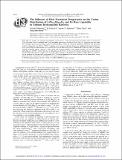The Influence of Heat-Treatment Temperature on the Cation Distribution of LiNi[sub 0.5]Mn[sub 0.5]O[sub 2] and Its Rate Capability in Lithium Rechargeable Batteries
Author(s)
Yabuuchi, Naoaki; Lu, Yi-Chun; Mansour, Azzam N.; Chen, Shuo; Shao-Horn, Yang; Lu, Yi-chun; ... Show more Show less
DownloadShao-Horn_The Influence of heat.pdf (1019.Kb)
PUBLISHER_POLICY
Publisher Policy
Article is made available in accordance with the publisher's policy and may be subject to US copyright law. Please refer to the publisher's site for terms of use.
Alternative title
The Influence of Heat-Treatment Temperature on the Cation Distribution of LiNi0.5Mn0.5O2 and Its Rate Capability in Lithium Rechargeable Batteries
Terms of use
Metadata
Show full item recordAbstract
LiNi[subscript 0.5]Mn[subscript 0.5]O[subscript 2] samples were prepared from NiMnO[subscript 3] and Li[subscript 2]CO[subscript 3] in a range of temperatures from 900 to1050°C . Synchrotron X-ray diffraction analysis combined with X-ray absorption spectroscopy showed that LiNi[subscript 0.5]Mn[subscript 0.5]O[subscript 2]segregated into one major Ni[superscript 2+]O -enriched phase and one minor Li[subscript 2]Mn[superscript 4+]O[subscript 3] -enriched phase, where the extent of segregation decreased with increasing synthesis temperature from 900 to1050°C . Scanning and transmission electron microscopy combined with energy dispersive X-ray spectroscopy revealed that the segregated domains exist in individual particles. Although all of the LiNi[subscript 0.5]Mn[subscript 0.5]O[subscript 2] samples showed comparable specific capacity (∼200mAh/g) and capacity retention at low current densities, the rate capability of LiNi[subscript 0.5]Mn[subscript 0.5]O[subscript 2] of 900°C is lower than that of LiNi[subscript 0.5]Mn[subscript 0.5]O[subscript 2] of 1000°C . As X-ray photoelectron spectroscopy analysis showed that all of the LiNi[subscript 0.5]Mn[subscript 0.5]O[subscript 2] samples had comparable surface chemistry, the higher rate capability of LiNi[subscript 0.5]Mn[subscript 0.5]O[subscript 2] of 1000°C can be attributed to reduced cation segregation of Ni[superscript 2+]O -enriched domains in the layered structure of the major phase, having potentially faster lithium diffusion than that of LiNi[subscript 0.5]Mn[subscript 0.5]O[subscript 2] of 900°C .
Date issued
2010-12Department
Massachusetts Institute of Technology. Department of Materials Science and Engineering; Massachusetts Institute of Technology. Department of Mechanical EngineeringJournal
Journal of The Electrochemical Society
Publisher
Electrochemical Society
Citation
Yabuuchi, Naoaki, Yi-Chun Lu, Azzam N. Mansour, Shuo Chen, and Yang Shao-Horn. The Influence of Heat-Treatment Temperature on the Cation Distribution of LiNi[sub 0.5]Mn[sub 0.5]O[sub 2] and Its Rate Capability in Lithium Rechargeable Batteries. Journal of The Electrochemical Society 158, no. 2 (2011): A192.
Version: Final published version
ISSN
00134651
1945-7111